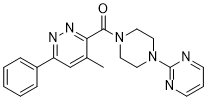GIBH-130
This product is for research use only, not for human use. We do not sell to patients.

For small sizes, please check our retail website as below: www.invivochem.com
| Size | Price | Stock |
|---|---|---|
| 250mg | $1350 | Check With Us |
| 500mg | $1900 | Check With Us |
| 1g | $2850 | Check With Us |
Cat #: V21579 CAS #: 1252608-59-5 Purity ≥ 98%
Description: GIBH-130 is a neuroinflammation inhibitor.
Top Publications Citing Invivochem Products
Publications Citing InvivoChem Products
Product Promise

- Physicochemical and Storage Information
- Protocol
- Related Biological Data
- Stock Solution Preparation
- Quality Control Documentation
| Molecular Weight (MW) | 360.41 |
|---|---|
| Molecular Formula | C20H20N6O |
| CAS No. | 1252608-59-5 |
| SMILES Code | O=C(C1=NN=C(C2=CC=CC=C2)C=C1C)N3CCN(C4=NC=CC=N4)CC3 |
| Synonyms | GIBH-130; GIBH 130; GIBH130 |
| Protocol | In Vitro | GIBH-130 is a novel antineuroinflammatory agent that is identified through microglia-based phenotypic screenings. GIBH-130 (IC50 3.4 nM) is identified in screenings as one of the most effective inhibitors with an acceptable half-life. Pretreatment of microglia with GIBH-130 significantly reduces the production of these factors in response to Lipopolysaccharides (LPS) stimulation, and the extent of the reduction is dependent on the concentrations of GIBH-130. The IC50 values of GIBH-130 for NO and TNF-α inhibition are 46.24 and 40.82 μM, respectively. Notably, pretreatment with GIBH-130 significantly suppresses the IL-1β secretion by activated microglia (IC50=3.4 nM). The inhibitory efficiency of GIBH-130 at 20 nM is comparable to 20 μM minocycline against IL-1β release. IL-1β is one of the major cytokines during neuroinflammatory progression of AD. So, it is meaningful to explain the selectivity of GIBH-130 against IL-1β (IC50 value 3.4 nM) over NO and TNF-α (IC50 value 46.24 and 40.82 μM, respectively) . |
|---|---|---|
| In Vivo | GIBH-130 exhibits comparable in vivo efficacy of cognitive impairment relief to donepezil and memantine respectively in both β amyloid-induced and APP/PS1 double transgenic Alzheimer’s murine models at a substantially lower dose (0.25 mg/kg). The pharmacokinetic properties of GIBH-130 are assessed in Sprague-Dawley rats. As a potential drug candidate targeting in CNS, GIBH-130 is found to be orally bioavailable in rats, with 74.91% bioavailability and 4.32 h half-life. In addition, GIBH-130 displays good penetration ability across blood-brain barrier (AUCBrain/Plasma=0.21). |
These protocols are for reference only. InvivoChem does not
independently validate these methods.
| Solvent volume to be added | Mass (the weight of a compound) | |||
|---|---|---|---|---|
| Mother liquor concentration | 1mg | 5mg | 10mg | 20mg |
| 1mM | 2.7746 mL | 13.8731 mL | 27.7462 mL | 55.4924 mL |
| 5mM | 0.5549 mL | 2.7746 mL | 5.5492 mL | 11.0985 mL |
| 10mM | 0.2775 mL | 1.3873 mL | 2.7746 mL | 5.5492 mL |
| 20mM | 0.1387 mL | 0.6937 mL | 1.3873 mL | 2.7746 mL |
The molarity calculator equation
Mass(g) = Concentration(mol/L) × Volume(L) × Molecular Weight(g/mol)
Mass
=
Concentration
×
Volume
×
Molecular Weight*
The dilution calculator equation
Concentration(start)
×
Volume(start)
=
Concentration(final)
×
Volume(final)
This equation is commonly abbreviated as: C1 V1 = C2 V2
Concentration(start)
C1
×
Volume(start)
V1
=
Concentration(final)
C2
×
Volume(final)
V2
Step One: Enter information below
Dosage mg/kg
Average weight of animals g
Dosing volume per animal µL
Number of animals
Step Two: Enter the in vivo formulation
%DMSO
+
%
+
%Tween 80
+
%ddH2O
Calculation Results:
Working concentration:
mg/ml;
Method for preparing DMSO master liquid:
mg
drug pre-dissolved in
µL
DMSO(Master liquid concentration
mg/mL)
,Please contact us first if the concentration exceeds the DMSO solubility of the batch of drug.
Method for preparing in vivo formulation:
Take
µL
DMSO master liquid, next add
µL
PEG300, mix and clarify, next add
µL
Tween 80,mix and clarify, next add
µL
ddH2O,mix and clarify.
Note:
- (1) Please be sure that the solution is clear before the addition of next solvent. Dissolution methods like vortex, ultrasound or warming and heat may be used to aid dissolving.
- (2) Be sure to add the solvent(s) in order.




































